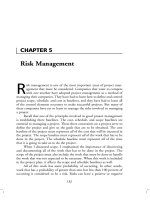Chapter 5: EC in Service Industries ppsx
Bạn đang xem bản rút gọn của tài liệu. Xem và tải ngay bản đầy đủ của tài liệu tại đây (289.88 KB, 55 trang )
1
© Prentice Hall, 2000
Chapter 5
EC in Service Industries
2
© Prentice Hall, 2000
Learning Objectives
❚
Understand how broker-based services are
performed online
❚
Describe online travel tourism services and their
benefits
❚
Discuss the impact of EC on the travel industry
❚
Describe the online job market, its drivers and
benefits
❚
Describe the electronic real estate market
❚
Understand how stock trading is done online and
its benefits
3
© Prentice Hall, 2000
❚
Discuss cyberbanking, its drivers and
capabilities
❚
Discuss implementation issues of online
financial services and its future
❚
Describe electronic auctions, their benefits,
implementation, and impacts
❚
Describe some innovative applications in the
service industries
❚
Discuss the future of intermediaries and their
role in cyberspace
Learning Objectives (cont.)
Opening Vignette:
Ordering Journals Electronically
❚
How a large university automated the
purchasing of magazines and journals,
saving $365,000/year
❚
Direct Marketing: Buyer-to-seller; orders and
payments
❚
Market maker charges $5/transaction Vs.
about $40 (conventional agents)
❚
Ordering time reduced by up to 80%
4
Electronic Commerce in Magazine Ordering
Opening Vignette:
Ordering Journals Electronically (cont.)
5
Publisher
Publisher’s
Bank
University
of California
Electronic
Catalogs
Buyer’s
Bank
BANC ONE
OM Transact
BANC ONE
Automated
Clearing
House (ACH)
Rowe. Com’s
Account
Rowe.Com System
EDI
Order +
Payment
EDI,
Internet
Order
Browsing
EDI Payments
Fee
$5 Fee
Payment
Buyer SellerIntermediary
6
© Prentice Hall, 2000
Broker-Based Services
❚
Brokers work as intermediaries between buyers and
sellers
❚
Agents basically make the markets
❚
Agents provide many services
❚
Most of the value-added tasks of brokers can be
automated
❚
Major electronic agent-based services
❙
travel
❙
employment
❙
real estate
❙
stocks
❙
electronic auctions
❙
at-home banking
❙
insurance
7
© Prentice Hall, 2000
❚
Service Industries Vs. Manufacturing and
Product’s Retailing
Broker-Based Services (cont.)
❙
Service Industries
❘
pure EC ⇒ substantially reduced cost
❘
bank and brokerage houses
•
possible digitization of the entire process
❘
travel and real estate agents
•
viewing an online video clip or seeing photos of a hotel
or a house for sale
❙
Manufacturing and Product’s Retailing
❘
physical delivery cost may be high
8
© Prentice Hall, 2000
Travel and Tourism Services
❚
By the year 2000, close to 25 percent of all
business-to customer Internet commerce will
be related to tourism
❚
The Internet is an ideal place to plan,
explore, and arrange almost any trip
❚
IBM’s vision of seamless electronic travel
using smart cards
9
© Prentice Hall, 2000
❚
Services Provided
Information and booking
of airlines, hotels, cars,
and even golf courses
Fare comparisons
360 degree
video tours of
top destinations
Electronic Travel
magazine
Tips provided by people
that experienced certain
situations (like a visa
problem)
Pictures of major
attractions
Providing maps
Information about
entertainment and ticket
purchasing (such as
www.ticketmaster.com)
Converting 200
currencies
Travel and Tourism Services (con t.)
Worldwide
business and
places locator
E-mail to
intermediary
Chat rooms
and bulletin
boards
Major international news
Weather watch
Experts’ options
Shopping for travel
accessories and
books
Special
interest
vacations
Current status
of flights
(real time)
Fare tracker (free
e-mail alerts on
low fares)
Bed and breakfast
recommendations
Restaurant reviews
Special discount
information
Frequent
flier deals
Travel news
Driving directions
in the US
Travel and Tourism Services (cont.)
10
© Prentice Hall, 2000
11
© Prentice Hall, 2000
❚
Benefits and Limitations
❚
Limitations
❙
Not all people use
the Internet
❙
It may take a long
time to find what
you want
❙
People are still
reluctant to
provide credit
card numbers
❚
Benefits
❙
Free information is
tremendous
❙
Free information is
accessible anytime
❙
Substantial discounts
Travel and Tourism Services (cont.)
12
© Prentice Hall, 2000
❚
Corporate Travel: New Business Model
❚
The Impact of EC on the Travel Industry
❙
Porter’s framework of competitive advantage (the
five forces)
❙
Focus:
❘
environment
❘
competitive responses
❘
firm’s strategy
❙
The industry is clearly transformed
❙
Taking away some functions traditionally performed
by travel agents
Travel and Tourism Services (con t.)
13
© Prentice Hall, 2000
❚
Impacts on the industry
Travel and Tourism Services (cont.)
❙
Multimedia helps customers understand the
products
❙
Offering of lower-cost trips
❙
Providing a more personalized service
❙
Saving money in a paperless environment
❙
Increasing the convenience of getting
information at home
❙
Supporting a customer-focused strategy (such
as targeted advertisement and integration of
products); push information to customers
14
© Prentice Hall, 2000
❚
Travel agencies, as we know them today, will
disappear
❚
Only their complex value-added activities will
not be automated
❚
These complex activities will be performed
by a new breed of intermediates
Travel and Tourism Services (con t.)
15
© Prentice Hall, 2000
❚
The Future
Travel and Tourism Services (con t.)
❙
Collaborative organizational process performed
by multiple organizational intelligent agents
❙
Acting autonomously
❙
Work cooperatively
❙
Work collectively to achieve the collective goal
❙
Example — How will your next vacation be
planned, booked and paid for?
16
© Prentice Hall, 2000
The Employment Placement Market
❚
Job markets
❙
Employers are looking for employees with
specific skills, and individuals are looking for a
job
❙
Very volatile market
❙
Moved to the Internet
❙
Millions of job seekers, hundred of thousands of
jobs
17
© Prentice Hall, 2000
❚
Shortcomings of the Non-Internet Job Market
The Employment Placement Market (cont.)
❙
Cost—Classified ads are expensive.
❙
Life cycle— Unless renewed, at an additional cost, the
life of the ads is only days or weeks.
❙
Place— Most ads are local. Nationwide ads are very
expensive. International ads are even more expensive.
❙
Minimum information— Because of the high cost, the
information provided is minimal and may not appeal to
some job seekers.
❙
Search— It is very time consuming for individuals to find
all relevant newspapers. A trip to a library results in
finding only major out of town newspapers.
18
© Prentice Hall, 2000
❙
Finding applicants— Most job seekers, in the pre Internet era,
did not place ads about their availability. Some sent unsolicited letters
with resumes. This situation made it difficult for companies to find
employees with special skills. They had to use employment agencies
and pay them high commissions.
❙
Matching— It was difficult to match candidates to open jobs as
well as to match supply and demand.
❙
Lost and dated material— Some applications or letters of
response tended to get lost, or arrive late. A letter in a big city may
travel two weeks to arrive at a distance of a few blocks.
❙
Speed— Communication by mail is slow and so is the processing
of a large number of applications. Frequently, employers lose good
employees, since by the time the application is processed, the
applicant had taken another job. Similarly, applicants accept less
desirable jobs because they are afraid to wait too long.
The Employment Placement Market (cont.)
19
© Prentice Hall, 2000
❚
The Internet Job Market
The Employment Placement Market (cont.)
❙
The Internet offers a perfect environment; it is
especially effective for technology-oriented
jobs.
❘
Job seekers
❘
Job offerers
❘
Recruiting firms
❘
Government agencies and institutions
20
© Prentice Hall, 2000
❚
The Advantage of the Electronic Job Market
The Employment Placement Market (cont.)
❙
For job seekers
❘
Ability to find very detailed and timely information on a
large number of jobs world-wide
❘
Ability to quickly communicate with potential employers
❘
Ability to post resumes for large-volume distribution
❘
Ability to search for jobs quickly from any place at any
time
❘
Obtain several support services at no cost
•
writing resume ⇒ career development ⇒ how to interview
❘
Find employer profile & industry guides
•
www.valuereports.com
21
© Prentice Hall, 2000
❙
For employers
❘
Ability to advertise to a large number of job seekers
❘
Ability to save on advertisement costs
❘
Lower the cost of processing (using electronic
application forms)
❘
Ability to provide greater ‘equal opportunity’ for job
seekers
❘
Ability to find highly skilled employees
❘
Ability to conduct tests quickly, online
❘
Ability to change and update ads quickly
❘
Ability to fill up positions rapidly
❘
Interviewing from distance
The Employment Placement Market (cont.)
22
© Prentice Hall, 2000
❚
The Limitations of the Electronic Job Markets
The Employment Placement Market (cont.)
❙
Many people do not use the Internet
❙
Security
❙
Privacy
❙
Lack of face-to-face contact
23
© Prentice Hall, 2000
❚
Major Services Available on the Net
❙
Finding a job
❙
Writing and posting resumes
❙
Career planning
❙
Newsgroups
❚
The Intranet Job Market
❙
Most companies organize an internal electronic
job market
❙
Openings are posted for employees to look at,
and search engines enable managers to identify
talents even if the people were not actively
looking for a job change
The Employment Placement Market (cont.)
24
© Prentice Hall, 2000
Real Estate: From Virtual Realtors to Virtual
Reality
❚
You can view many properties on the screen
❚
You can sort and organize properties
❚
You can find detailed information about the
properties
❚
You can search, compare and apply for loans
25
© Prentice Hall, 2000
❚
Real Estate Applications
Real Estate: From Virtual Realtors to Virtual
Reality (cont.)
❙
International Real Estate Directory and News is
the most comprehensive Web site
www.ired.com
❙
National listing of real estate properties
www.cyberhomes.com
❙
Commercial real estate directory
www.comspace.com
❙
The complete real estate software catalog
www.mnink.com/re/cover.html









